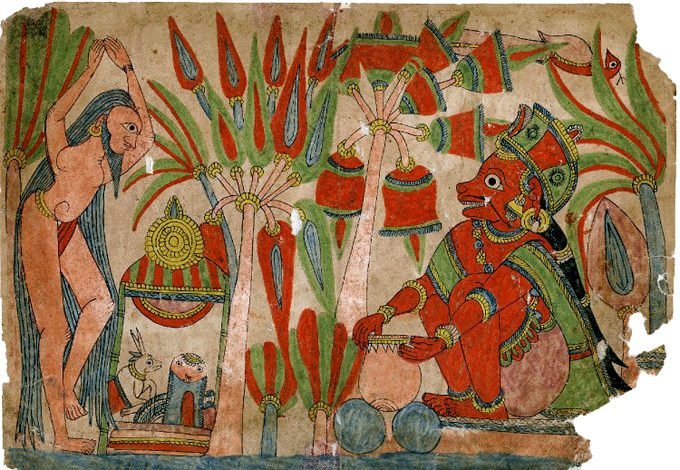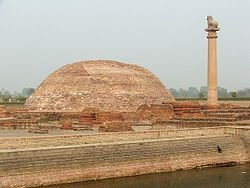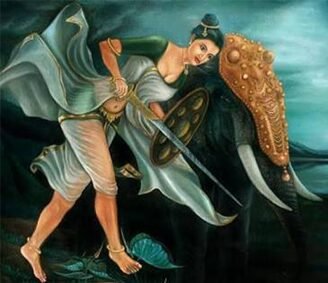MahaJanpada: Vajji – The rulers of eight clan

The end of the Vedic period saw tribal allegiance make way for territorial allegiance and that the people’s loyalty were getting transferred from tribal organisations to polito-geographical units. This type of development was seen to be reflected in a relationship between the raja and others based on the reciprocity rather than kinship, but there was also an indication of the emergence of a class of non-kinsmen who eventually became the cronies of the raja contributing towards the concentration of the authority in the throne. These civilisations which emerged were named as Janapadas, and some of these janapadas had soon grown into mahajanapadas with more than one urban settlement. The legal and ideological outfit in those mahajanapadas were supported by a well defined caste system under which the producers were saddled with economic obligations as well as social disabilities.
The term janapada, when referred to in the context of the mahajanapada, basically meant a land where people lived through many generations and were linked to each other not only through blood and geography but also through customs, religion, rituals, and dialects. They were made up of a number of nagaras (cities) nigamas (trading centres), and gamas (villages), and was based on a gemeinschaft-type of society. It was formed naturally, thus it neither had any well-defined territorial bounds nor did it include uninhabited places, such as ghost towns and wasteland. Among all the sixteen mahajanapadas mentioned in the early Pali texts, Vajji is considered to be one of the most important ones, it is mentioned within the first fourteen janapadas in the Pali texts and is thus included in the Majjhimadesa also.

Vajji was one of the main Mahajanapadas of ancient India, its capital used to be Vaishali. In the Buddhist text Anguttar Nikaya and the Jain text Bhagwati Sutra, it has the status of 16 Mahajanapadas. The Vajji dynasty had also been mentioned by Chanakya, Panini and Xuanzang. The mahajanapada of the Vajji people, with its headquarters at Vesali, was basically a confederacy of several clans among whom the clans of the Licchavis and the Videhas were known to be the most dominant.
The name “Vajji” has been derived from its ruler Vujis. On the basis of a reference in the Sumangala-Vilasini that atthakulaka were responsible for administering justice in the country of the Vajjis, it has sometimes been conjectured and assumed that the Vajjian confederacy was composed of nearly eight clans, but there is no other evidence to indicate this that the number of confederate clans was indeed eight. With the passage of time, the Licchavis had appeared to become so powerful that the names of Vajji and Licchavi had began to be used synonymously. According to the tales, Xuanzang had visited this place in the seventh century and as described by him, the Vajji country was broad from east to west and narrow from north to south during that period.The Vajjian territory was bounded on the north and the east by the Bagmati river and the entire area between the Gandaka and Bagmati used to lie in the Vajji territory and thus included the present day Begusarai, Samastipur, Muzaffarpur, Motihari and Betiah in the Vajji mahajanapada.
The river Vaggumuda flowed through the Vajjian mahajanapada also. During the time of the Buddha, the Vajjians were a prosperous and a very powerful mahajanapada. This was so because, according to the Buddha, the different clans were united among themselves and thus formed a closely knit community, increasing their strength in the process. The area they used to rule, constituted of the region of Mithila in northern Bihar and their capital was the city of Vaishali as already mentioned. Their administration was called “Vajji Sangha” or “Vajji Gana Parishad”. Vajji was the backbone of many important organisations of the surrounding tribes, including the Licchavis. Buddhist monks have taken a considerable amount of inspiration from the Vrijji government’s organisational structure to form their religious order. Chandragupta had built the Mauryan Empire by marrying a Licchavi princess in the 4th century BCE. Vaishali, the capital of the Vajji dynasty, is presently located in modern-day Bihar. Meanwhile, Vajji was always ruled democratically while Magadha was the opposite and was ruled monarchically. People used to use the term sangha to denote the government. A game had been ruled by a group known as the raja rather than a single individual. There is a Buddhist legend which holds that a diamond mine once stood near the village on the banks of the Ganges.

According to the legend, the Licchavis of Vajji and the Ajatashatru of Vajji would receive an equal part. It was only on one occasion when Ajatashatru was unable to collect his share of the weight, and it was taken over by the Vajjians instead. Ajatashatru was sick with this and thought it was time to give up. Vaishali’s confederacy was so powerful that it was nearly difficult and impossible to take on the entire group. These mighty Vajjis must be exterminated off the face of the Earth. And as a matter of fact, Vaishali’s invincibility was explained to Vadakara by Buddha, who gave him seven reasons, including Vajji’s punctuality, their respect for elders, their respect for women, and that they do not marry their daughters forcefully, and the Chaityas inside the town. Thus to break the Vajji confederacy and destroy the altars at Vaishali, Ajatashatru had sent his chief minister Vassakara as an infiltrator.

And thus it became an easy victory for Ajatashatru, who had attacked the town from both sides with a scythed chariot and a swinging mace and blades. Each of the eight clans present in Vajji had been independent and autonomous. Vajji was always administered by a Vajji Sangha (Vajji confederation, as stated above), which consisted of several janapadas, gramas (villages) and gosthas (groups). The eminent people of the administration were chosen from each khandas (districts), to represent them in the Vajji ganaparishad (people’s council of Vajji). These representatives were also called ganamukhyas. The chairman of the council was called ganapramukh (head of the state), but people often addressed him as the king, even though his post was not dynastic. The other executives were known as mahabaladhrikrit (equivalent to the minister of internal security), binishchayamatya (chief justice), and dandadhikrit (other justices).Vaishali had been both Buddhist and Hindu while Vrijji was predominantly Hindu and the capital of it was Zhanshuna.
Vajji, Pali Bihar was a union of Lichchhavis in India, which existed from the 6th century to the 4th century. It was included as a prestigious republic. Gautam Buddha modeled the organizational structure of the Buddhist monastic sangha on the government of Vrajji.
The rulers here were a group of eight clans, in which the Vajjis, Lichchavi, Kshatrik and Videha were. However, according to the Sutrakritanga, Ugra, Bhoja, Kaurava and Ikshvanku were famous rulers here.

According to Jain and Buddhist traditions, it has been told differently how the war took place, but in both the traditions it is clearly told that Magadha was victorious. It is said that it was ensured by King Ajatashatru and Vajjio of Magadha that in a village near the Ganges river there would be an equal share in the diamond mine but Ajatashatru would have his share Could not succeed in taking it and the whole part was taken by Vijjayo. Then Ajatashatru decided to destroy Vijjayo and with the help of his minister Vaskar got the victory by dividing Vajjiya.


